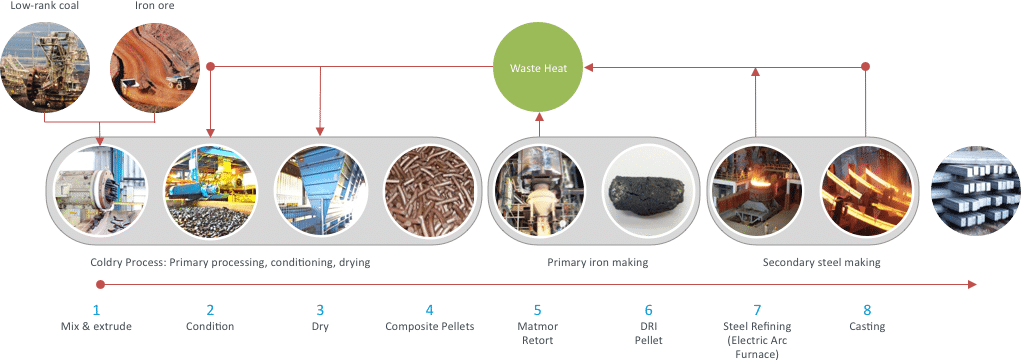Technology

Detail
World’s first lignite-based iron making technology
The Process
HydroMOR is a unique method for producing high-quality iron from inexpensive, abundant brown coal and iron oxide bearing material such as mill scale, nickel tailings and, of course, high or low-grade iron ore.

Stage 1: Composite Pellet Production
- Using the Coldry Process, the raw materials are milled to <8mm, combined with a small amount of water, mixed and extruded
- The extruded mixture is conditioned until dry-to-the-touch
- The semi-dry pellets are conveyed into a vertical packed bed dryer, where warm air provided by waste heat is circulated through the bed of pellets, removing the evaporated moisture
- The Composite Pellets are discharged at the base of the dryer and conveyed to the HydroMOR Retort
Stage 2: HydroMOR Retort
- The Composite Pellets are charged via the top of the HydroMOR Retort
- The Retort heats the pellets in a reducing atmosphere
- As the Composite Pellets travel down the retort, various reactions take place:
- Gasification of the volatile matter in the lignite produces hydrocarbon gases
- Catalytic thermal decomposition of the hydrocarbons produces hydrogen
- Hydrogen reduces the iron oxide to iron, producing H2O or water-gas
- Reactions within the retort result in the chemical looping of hydrogen, amplifying reduction
- The reduced pellets are discharged at the base of the retort and contain carbon, iron and ash
- The reduced pellets can be cooled and stored or melted in an electric arc or induction furnace for secondary steelmaking
- The liquid metal is then cast to the desired product format
The Product
| Indicative Composition | % |
|---|---|
| Fe | 98% |
| C | 1% |
| Other | 1% |
The HydroMOR Process delivers a clean iron product tailored to the size/shape and carbon content requirements of the end-user.
The HydroMOR Process delivers a clean iron product tailored to the size/shape and carbon content requirements of the end-user.
The above iron was produced from the following inputs:
| Iron Ore | % Dry Basis |
|---|---|
| Fe | 67.42 |
| SiO2 | 2.15 |
| Ni | 0.03 |
| TiO2 | 1.02 |
| V | 0.37 |
| MgO | 2.25 |
| Al | 0.27 |
| CaO | 0.80 |
| Mn | 0.09 |
| Cu | 0.004 |
| P | 0.011 |
| S | 0.057 |
Features & Benefits
The advantages of the HydroMOR Process over traditional blast furnace iron making are:
- Replacement of expensive metallurgical coal with cheap, abundant lignite
- The opportunity to replace expensive high-grade Iron Ore (60%+Fe) with cheaper, low-grade Iron Ore
- Able to recover iron from millscale and other waste materials
- Process requires significantly less heat/energy
- Capital cost less than traditional blast furnaces for equivalent production capacity
- Recirculation of waste gases minimises emissions
- Lignite, as a reductant, is more chemically reactive than the black coal currently used in traditional primary iron production.
The advantages over alternate Iron making processes are:
- HydroMOR is the only lignite-based process
- Economic at a smaller scale
- Lower emissions
- Able to recover iron from waste streams such as millscale and nickel tailings
Intellectual Property Strategy
Our core asset is our Intellectual Property and, as such, must inform and leverage our Business Strategy.
Key aspects of IP protection include:
- Patents
- Confidentiality Agreements – Comprehensive agreements cover engagement with potential partners and customers
- Licence Agreements – Technology Transfer is protected by detailed agreements to minimise risk and maximise compliance.
| Country | Patent / Patent Application No. | Status |
|---|---|---|
| Australia | 2017365702 | Granted |
| Canada | 3043483 | Granted |
| China | 202311810043.1 | Pending |
| European Patent Office | 3545111 | Granted |
| Hong Kong | HK40015374 | Granted |
| Indonesia | PID201905113 | Registered |
| India | 476241 | Granted |
| Russian Federation | 2765478 | Granted |
| USA | 18/352745 | Pending |

